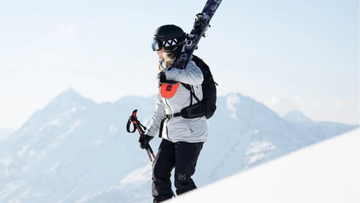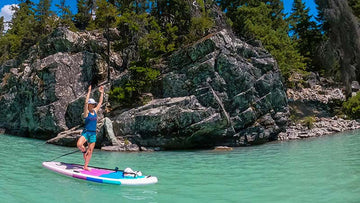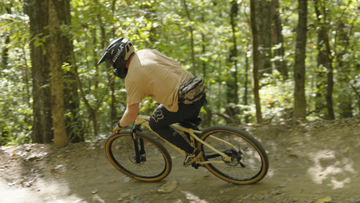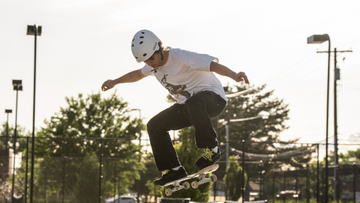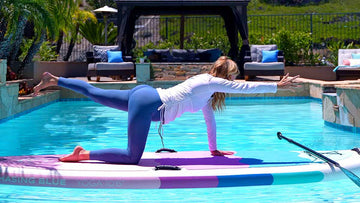SUP means stand-up paddle board. It is a board made up of double layers of PVC sheets. SUP yoga is a form of yoga on the paddle board. Yoga on a paddle board has many advantages over normal yoga: Doing yoga on a floating stand up paddle board in the water and provides proximity to nature. Humans are made up of more than 70% water, so it is our natural tendency to feel good near water.
Paddleboarding yoga boosts concentration as one can practice yoga and meditation side by side. It is difficult as it involves balancing the body and the paddle board. The laws of balancing behave differently on earth than on the water surface.
Therefore, a common myth is that only experienced yogis can practice SUP yoga. The participants for Paddle board yoga are increasing from 1 million in 2010 to 2.8 million in 2014 in the United states of America. Here in this article, a beginner's guide is provided to practice and enjoy paddle yoga.
Before I get you started, make sure to join our dedicated SUP Facebook Group, we have a SUP yoga instructor Kelly Huck in the group who will be happy to answer any of your stand up paddle board yoga related question.
Table of content
Why do you need SUP yoga? Practice tips of SUP yoga: SUP Yoga safety tips Gearing up for SUP yoga 15 SUP yoga poses for beginners with printable pdf SUP yoga with Kelly Hulk Frequently Asked questionsWhy do you need SUP yoga?
Stand up paddle board yoga has many advantages over regular yoga as it is practiced on the water surface using a paddle board. Following are the key aspects of practicing paddleboard yoga poses:
- Paddle yoga is practiced on the water surface, such as the ocean, lakes, and swimming pools. Yoga on the water surface increases the effort to balance the body in a specific pose. In this way, SUP yoga improves balance and core strength
- Yoga on paddleboard is observed in an open water body where the person feels close to nature and is more focused than on yoga mat.
- Stand up paddle board yoga is done away in the open ocean; this one hears natural sounds like ocean waves and birds. Natural sounds tend to relax our minds and boost focus and energy.
- Paddle yoga is important to make yoga interesting as doing yoga in-home can be tedious and repetitive.
- SUP yoga allows you to shift from one pose of yoga to another in the low and minimal movement to keep the balance maintained. It improves core and hip muscles more than the traditional form of yoga.
Practice tips of doing paddle board yoga poses
Yoga on the paddle board is difficult and unattainable as it needs proper balancing and a good paddle board. Here are a few tips to improve SUP yoga and make it doable for beginners.
- Select a good-quality paddle board for SUP yoga. The Paddleboard should be wide with excellent buoyancy and the best PVC quality.
- Try to maintain two points of contact while practicing yoga on the paddle board to avoid turbulence in the paddle. Practice two-point yoga position at home a day before going for SUP yoga. Downward dog, child's pose, and side plank are easily doable positions in the Sup yoga.
- Speed is the key factor in SUP yoga because the sudden change in postures can shake the paddle board. Try to lower the speed of changing poses compared to on a flat surface.
- Take a wider stance than on the land to maintain balance on the board
- Adopt poses that keep the center of gravity lower than on the land; thus, lower the center of gravity will be the chances of falling off the board.
- The best advice for beginners is to take things slow, it is ok to fall sometimes, but the key is never giving up. Always be prepared to fall off the board, and then be prepared to start again.
- Try to plan a yoga day as weather can affect the SUP yoga plan. Wind shakes the paddle boards and imbalances the whole board, making it difficult to use for yoga.
- Wear comfortable yoga pants and shirts to achieve maximum flexibility and stretching.
- Always try to maintain low body positions while doing yoga on the paddle board to maintain balance on the paddle board.
- Try to keep the belly button in the mid of the paddle board in every yoga pose to maintain balance and avoid turbulence on the board.
- Modify yoga poses with wide legs and arms for better balance and stability.
Stand-up paddle board yoga safety tips
Paddle boarding yoga is interesting as well as new for many people. Even the yoga expert needs proper knowledge and understanding to practice SUP yoga in the middle of an ocean or lake. The proximity to nature in SUP yoga makes it an interesting and appealing type of yoga for many adventurous, loving people. Before you jump into practicing SUP yoga as a beginner, there are many safety measures.
- Buy a good-quality paddle board. Before buying a paddle board, make sure the paddle board has the following features.
1. The Paddleboard should be wide and thick enough to have good buoyance and be suitable for doing yoga. For example, 35’ is an ideal width for yoga SUP, as for thickness, 5-6 inches is recommended because it increases the rigidity of the iSUP, makes it more stable to SUP yoga.
2. Paddle boards are made of PVC fibers and threads woven together. Check the quality of PVC and the threads. A double-layered PVC paddle board makes it light and suitable for yoga.
3. Make sure the paddle board has Bungee Cargo System: The Yoga Paddle Board tail is equipped with a detachable 4-point bungee cargo system for more carrying possibilities.
4. The carry handle of an inflatable yoga paddle board is designed for extra holding comfort and a firm grip while carrying your board with a foam core. It helps enhance safety and keep the balance on the board, enjoy your yoga movement, and leads naturally to meditation.
5. Eva pad should be a Non-slip Croco-diamond deck pad that is comfortable underfoot, offering extra grip & traction.
6. D ring should be 12 Multi-function Stainless Steel D-Rings for seat mounting, coil leash binding, etc.
7. The valve in the paddle board should be a Double closed inflating valve with spring control. When the sup yoga board inner pressure is too high, the valve will automatically release some air to ensure stable air pressure.
- Check the weather before going for SUP yoga, as SUP is practiced in the open sky and the wide ocean, so any change in weather would affect and disturb the paddle board. Such as wind can disturb the balance and makes it impossible to do yoga. High ocean waves can ruin the plan of doing yoga, as a paddle board should be stable and anchored to the surface.
- Always take your safety gear, PFD (personal floatation) device, and properly working equipment. A personal floatation device is a low-profile way to keep yourself safe and still be able to practice SUP yoga on a paddle board.
- Bring your anchor and emergency whistle to call for help in case of emergency. Try not to go far from the shore as there can be an accident in the ocean or lake.
- On the safe side, it’s always a good idea to practice SUP yoga with friends and family or with some trainer to avoid any injury or accident. There is no harm in doing it alone if you are educated enough.
- If you are going to remote locations to practice SUP yoga, make sure to inform your family and friends about it. Share your location with your friends and family in case of emergency; they can find you.
- If the conditions allowed, try to keep your phone with you using the waterproof phone bag while doing SUP yoga alone in case you need to contact for help.
Gearing up for stand up paddle yoga
Prepare your gear bag before you plan for SUP yoga. Following are the gear items to have on SUP yoga,
Stand Up Paddleboard

Swordfish - iSUP BOARD + Dolphon Pump Bundle
$399.99
Shop NowUse code OMBLOG20 FOR 10% OFF!
Choose a paddle specifically made for paddle yoga. The Paddleboard should be wide, stable, soft, and Cushing. Make sure you buy a board appropriate for SUP yoga.
Paddle

3-piece Adjustable Paddle - Carbon Fiber
Shop NowChoose a paddle size specifically made for SUP yoga. Set the paddle perpendicular to your board and close to the nose. It would be best if you wrapped the leash around the paddle a few times to keep it secure and let it float behind the paddle in the water.
Emergency whistle
Take an emergency whistle with you to call for help.
Personal floating device (PFD)
Take a personal floating device with you on your yoga day to be on the safe side. Choose a lightweight and easy-to-wear PFD so that it doesn't hinder stretching and yoga poses. PFD protocols are different for different states and vary according to age, so ensure you read them before night.
Water
Water is important for any outdoor activities! Practicing yoga usually makes you sweat, that’s why water is essential for any form of yoga. Make sure you bring water bottle and stay hydrated while doing SUP yoga out there on the water.
Paddle Board Yoga Class for Beginner with Kelly Huck
Shoulder stretches
Grab the paddle in both hands and reach the pedal up to the sky, hold there for a while, then take the pedal back behind you, you might feel a little bit of resistance, if that happens to you, go ahead and take your hands even wider so the more you do this motion, the more opening you're going to find.
- The next stretch with the paddle on requires you to take your paddle again with shoulder distance, maybe a little wider and we'll take the paddle up to the sky. Start taking one side of the paddle down towards the water. This is going to open up one side of the body, then take your gaze down to the water just so that you’re gentle on the back of the neck. You're creating space in this whole left side of your body in this pose. Use an inhale to come back to neutral and then same motion to the opposite side. After this pose, you can put your paddle down on the board perpendicular, and secure it with the bungee strap.
Child’s Pose
- Start child’s pose, you'll take your knees wide, big toes touching back behind you, hips sit heavy on the heels, then start to walk your hands forward towards the nose of the board and allow your forehead to rest on the board. You can also tuck your palms and rest your forehead on the back of your hands. Let the weight of the hips possibly open up your hips. Smooth breath in and out, allowing the sun to create some heat and open the spine, this is a great way to open up the back side of your body. Then we'll walk back up to a seated position on our shins. Remember your belly button is going to be in the center of the board keep your belly button in this vicinity, and that's going to keep you stable.
Table Top - Cat/Cow Flow
- Place your hands in the front and put your knees back, if you want more stability, go ahead and tuck your back toes under, otherwise top of the feet on the board if you feel comfortable. Make sure your back is flat, and you are in a tabletop position. Now move through some cat/cows to continue to wake up the spine. On your inhale, lift your tailbone up towards the sky, look up, and your belly drops down towards the water. On your exhale, put the belly up away from the water, round your back, and tuck your chin in.
Another Child pose:
- Open up the knees wide, and sit back on the heels for another child's pose. This one is different than the last one, you will keep your hands out in front. Use an inhale, walk your hands over to the right rail of the board, then stack your left palm over on top of your right hand. Pin your left hip down, and breathe into the left side body, similar to the shoulder stretch, the hips are nice and heavy. Then use an inhale to walk your hands back to the center over to the left rail. Stack right hand on top of left hand, pin your right hip down and breathe into the right side body.
Downward-facing dog:
- Prepare yourself into the table top position, tuck your toes under, start to pick your knees up off the paddle board, and straighten out the back of the legs for your downward-facing dog. You might need to adjust yourself to get your belly button back over the center. Then hold this down dog for three breaths. Feel free to put a little Bend in the knees if the low back is tight. It’s super important to keep that bend in the knees to honor your low back. As you start to feel a little more comfortable, you can straighten out the legs maybe pedal the feet and then we're going to bring the knees back down to the table top to transition to child’s post. We suggest you work that sequence (Table top - Down dog - Table top - Child’s pose) a few more times, so that you will feel more comfortable moving around on the board.
3-legged dog
- Start with a downward-facing dog pose, then walk your feet together so that your ankles are touching, knees are touching. Imagine having only one leg, then start to take one foot off the board, this way you can start to lift up into three-legged dog. The board does not react to you taking a body part off the board, because you are totally centered. Exhale to put right leg down, reset the feet, then take the left leg up, press through the heel. You can always get back to a downward-facing dog, and if you need to rest, go for a child’s pose.
Balancing Table Top
- Start with a tabletop position belly button over the center of the board. You are going to take the right leg and extend it out back behind you. Keep your toes on the board for this first part then you're going to take your left arm and reach it out in front, at this point take your eyes off the board, then when you feel comfortable start to lift the back foot off the board. You want to keep the foot flexed which is the opposite of pointing the foot so the toes are pulling towards your face. Extend the heels, reach past the fingertips, and that’s balancing table top. Make sure you practice this pose on both sides.
Tiger Pose
- Take the right leg back, and left arm forward to balancing table top. From here, you can stay right here or if you want to challenge yourself a little more, go ahead and bend your back knee and see if you can grab your toe , or maybe your foot if you are capable of that, try to get your knee away from water. Then without slingshot in your foot, let go come back through balancing table top, and exhale back in table top position. Make sure to do the same on the opposite side, then come into child's pose in the end.
Low Lunge
- Let’s start with a table top pose, lift your knees up off the board, transitioning into downward-facing dog. Then you can use that three-legged dog, raising the right leg to get some length here because we're going to step the right foot forward next to the right thumb. Drop your back knee down as your anchor. Walk your right foot to the right rail, walk your back knee to the left, use the width of the board. Sink low with your hips, hips are heavy, they are going to wait us down towards the water. Next, bring your hands to your hips, at this point, your shoulders are stacked over hips, so you're balanced. Press your front foot, and take your arms out to the side and up to the sky. You can stay right here or start to take your gaze up, it’s a little bit more challenging. Do whatever you feel comfortable, then exhale, bringing the hands back down, tuck your back toes under, engage your core, and step your right foot back to downward-facing dog. Same concept, practice the low lunge on both side.
Seated pose
- At the end of the practice, let’s come to a seated position, any comfortable position for you, then take your arms up to the sky, exhale, move your hands to your heart. Feel free to close your eyes, bow your head, honor yourself for getting on your yoga mat today, whether it's floating or on land.
15 Paddleboard Yoga Poses for beginners
1. Shoulder Stretches:

Start with simple backward shoulder stretches. Sit in a comfortable position and bend your arms backward to stretch should joints. Try to inhale while moving backward and exhale, moving both arms forward.
Shoulder stretch is a great exercise to warm the shoulder muscles and shoulder joint. Keep this pose for a few seconds, then shift your arms to the right side to make a space on the left side. Stretch the left side of the ribs and create a space in the lungs. Then do it for the left side, shift the arms towards the left side and stretch the core muscles of the right side. Don't forget to inhale and exhale.
2. Hip stretches and leg stretch:

Stand on one leg in a lunge position and keep the other on the paddle to maintain balance. Stretch the bent knee to open the hip joint and stretch the hamstrings. Repeat it on both sides to stretch the hip joint. Then slowly sit on the legs to maintain a steady position, and raise your hips to stretch your hamstrings. To increase the stretch on the hip joint, extend your legs outward while touching the paddle floor with your hands.
To stretch legs and back muscles, sit comfortably on your hips and then extend the legs outward. Try to touch the toes just like stand toe touch position. It will stretch the knee joint as well.
3. Child’s pose:

The child's pose is the easiest yoga pose to practice on the SUP yoga day. First, sit and bend in a child's pose where the big toes of your feet are touching the paddle floor. Place your hips on your heels and walk slowly on your hands to go should length. Place your forehead on the paddle board to feel stretch in your back and neck. Maintain child's pose for 15 seconds.
4. Table top position:

Place your knees on the paddle wider than the usual tabletop position. Stretch your core muscles and look up, bringing your face upward. Try to inhale while the face is up and then exhale. Bring the face down in a tuck position; ribs contracted.
5. Low lunge position:

This pose is also known as the hamstring stretch position. Sit on your knees, then move one leg forward to stretch the hamstrings. Keep arms upward to engage the core and maintain balance on the paddle board. Exhale while bending the body forward and extending the front leg.
6. Mountain Pose:

It is a simple standing pose to focus on breathing movements and keeping hands on the chest in a prayer form.
7. Modified downward dog:
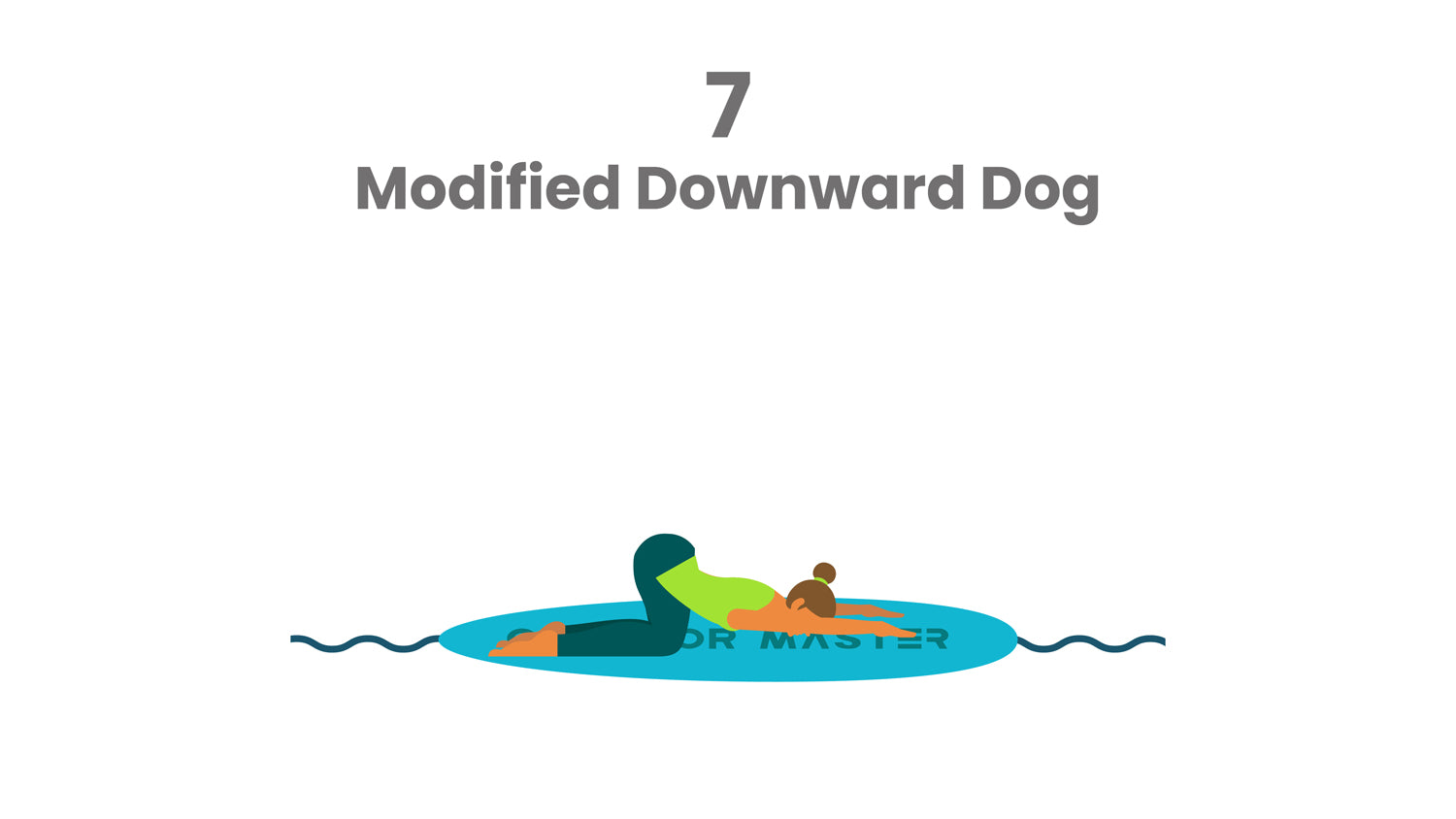
Sit in a comfortable position and try to walk on your hands and move your hips upward. Try to extend the legs; if not, you can bend your knees a little to maintain your posture. This pose will increase the focus and supply the brain with fresh blood. It stretches the legs and thighs. Maintain downward dog for 10 secs.
8. Leg extensions:

Be in a comfortable tabletop position and move one leg forward to maintain a leg extension or lunge position. Maintain this pose for both legs for 15 secs. Then move slowly to another pose to avoid any shakiness in the paddle.
9. Squat pose:

Sit on your feet and maintain a squat position. Try not to move up and down to squat as it is a squat yoga pose. Just try to hold this position for a few seconds.
10. Bridge pose:

Lie down on the paddle board, chest facing upwards. Bend your knees and make a bridge by lifting the hips to target hip flexors. Try to maintain this bridge pose for a few seconds. Bridge pose is an excellent way to target gluteal muscles.
11. Seated forward fold:

Sit on your hips on the paddle floor and extend both your legs forward. Try to touch your big toe to stretch the back muscles and knee joints. Bend you head down and try to go as low as possible to feel stretch in the hip joint.
12. Spine twist position:

Lie on the paddle floor, turn towards one side, and move the leg in the same direction. Try to feel stretch in the back and hip joint. Repeat the same exercise on both sides.
13. Cobra pose:

Lie down chest on the paddle floor and lift the head and upper body using your hands. Feel the stretch in the core muscles.
14. Side stretches:

Sit on the hips and open both arms. Bend both arms towards the right side to stretch the opposite side. Feel the stretch in the ribs and core muscles. Repeat on both sides.
15. Savasana:

It is a yoga finisher pose in which the yogi sits comfortably with open arms and legs. Try to focus on breathing and relax in this position.
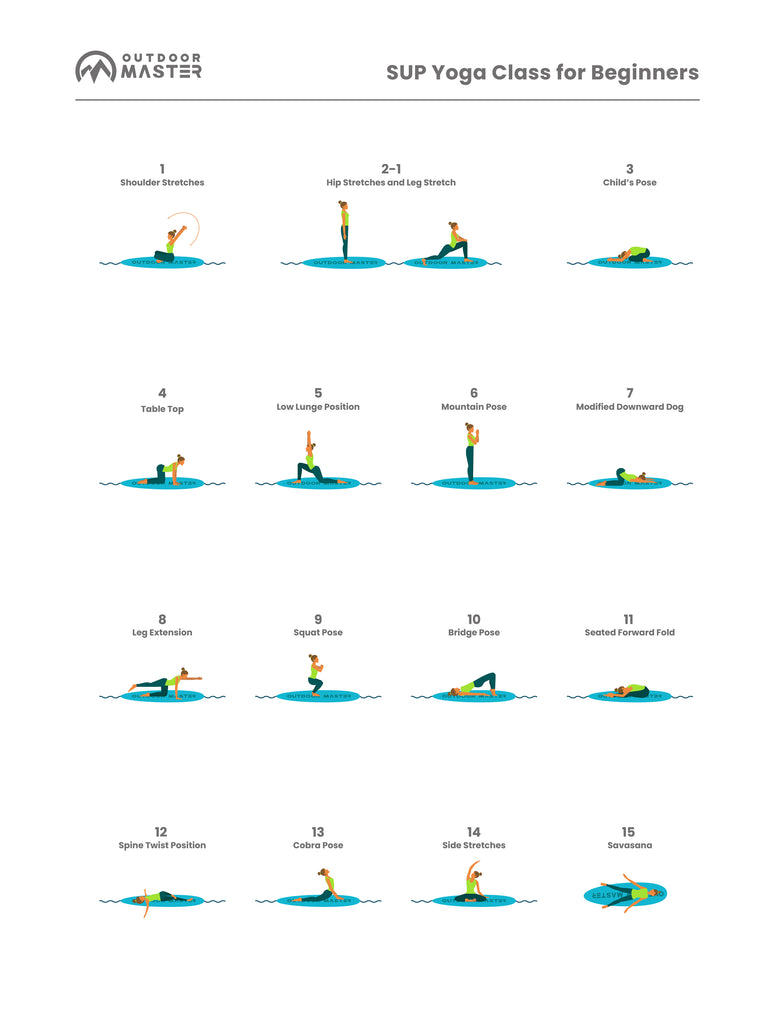
Click here for the printable pdf.
Frequently Asked questions
1. Is SUP yoga better than normal yoga?
Yes, SUP yoga is better because it is close to nature. SUP yoga focuses on core strength and improves balance.
2. Is SUP yoga for everyone?
Everyone can practice SUP yoga. The above article is especially for beginners, but everyone can practice SUP yoga with safety protocols.
3.Where can I buy Paddleboard for yoga?
Click here to buy a quality and affordable yoga paddle board.


